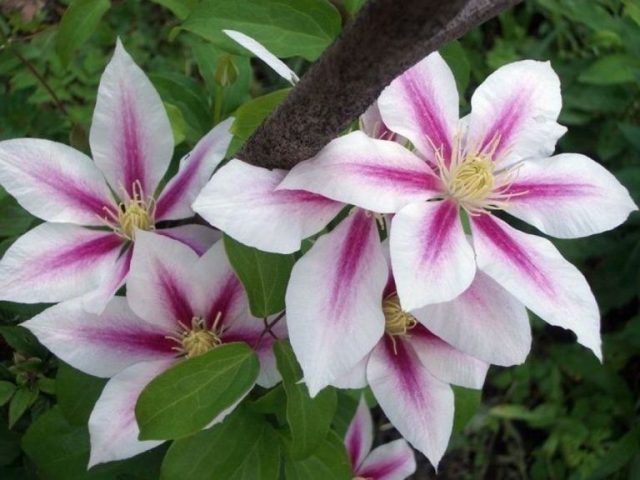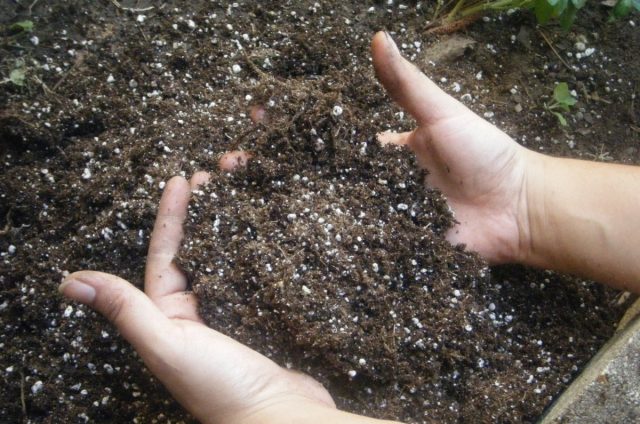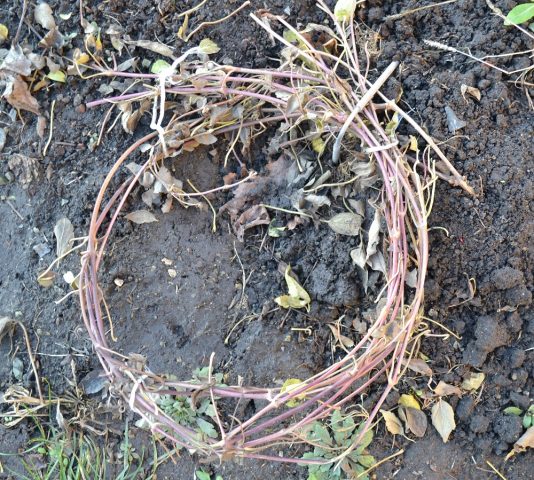Content
Clematis Andromeda is a tall climbing liana shrub with an abundant flowering type. The variety is classified as a large-flowered clematis; it blooms quite early. During the season, the plant is able to completely braid any supporting structure and cover with itself an unsightly wall of a living room, an old gazebo or a rickety fence. Vertical gardening is the main application of the Andromeda variety in landscape design.
Description of Clematis Andromeda
Clematis Andromeda is a two-color early flowering variety that forms fairly large flowers. Their diameter can reach 20 cm when grown in favorable conditions, the average length of the shoots is 3-4 m. Flowers are painted in delicate cream tones, approaching white, in the center of each petal on the inside there is a strip of deep dark pink color. The heart of the flowers is yellow. In spring and summer, clematis forms semi-double flowers, in autumn - solitary.
The first flowering occurs on last year's shoots, which emit a large number of buds. The second time, Clematis Andromeda does not bloom so abundantly.
Clematis Andromeda trimming group
In the description for the Andromeda variety, it is indicated that clematis belongs to the 2nd type of pruning. This means that immediately after its shoots have faded, a small part is cut off from them along with the seedlings. The purpose of such pruning is to stimulate re-flowering, due to which clematis throws out a much larger number of buds in the fall.
For the winter, the shrub is no longer cut so superficially. Only 50-80 cm of the total length is left from the shoots.
Planting and caring for clematis Andromeda
Large-flowered Clematis Andromeda is not capricious, but quite demanding variety. He does not like a transplant, so the shrub is planted immediately to a permanent place. If the plant still needs to be transplanted, clematis will bloom extremely weakly for several years, the growth of the shrub will noticeably slow down. This is explained by the fact that at this time clematis will be busy strengthening the root system, all nutrients will go to rooting.
Selection and preparation of the landing site
The site for planting clematis of the Andromeda variety should be selected taking into account the following recommendations:
- The culture of this variety grows poorly in the wind and does not like drafts, so it is planted in well-protected places with poor ventilation.
- For full development, the plant needs reliable support, so the Andromeda variety is placed near walls and fences. At the same time, it is important to maintain the distance between the shrub and the support - at least 40-50 cm.If clematis is planted next to a metal fence, this distance should be even greater, since the metal heated by the sun will inevitably burn the shoots and leaves of the plant.
- Excess light for the Andromeda variety is harmful, so it is best to place the shrub in partial shade. If you plant it in the sun, the clematis flowers will fade quickly.
- Clematis reveals its full potential on moderately moist soils with a high content of humus. Loamy or sandy loam soils are best suited.
- You can not plant clematis Andromeda in a lowland or in an area with a close location of groundwater - stagnant moisture and waterlogging of the soil have a detrimental effect on the root system of the plant. For prevention purposes, drainage is placed at the bottom of the planting pit so that the water does not stagnate.
Preparing a site for planting is reduced to digging and fertilizing. For these purposes, humus is usually used.
Seedling preparation
Two-year-old seedlings take root best of all. When buying planting material, you should pay attention to samples with a developed root system - healthy, strong seedlings should have at least 3 long roots (about 10 cm).
Preparation of planting material before planting involves soaking in cold water for 2-3 hours.
Planting rules for clematis Andromeda
A culture of the Andromeda variety is planted according to the following scheme:
- In a previously prepared area, a hole is dug with a depth of about 70-80 cm and a width of at least 50 cm.The optimal distance between two adjacent holes is 60-70 cm.
- A drainage layer approximately 20 cm thick is placed on the bottom of the pit. Broken brick, clay shards, gravel, pebbles or expanded clay can be used as drainage.
- A fertile soil mixture of the following composition is poured over the drainage: the top layer of garden soil taken from the pit, humus and compost taken in equal proportions. All this is thoroughly mixed and diluted with 100 g of superphosphate, 300 g of dolomite flour and 1-2 tbsp. wood ash.
- The resulting soil mixture is poured into the planting pit, filling it up to half, and forming a small mound from it. A clematis seedling is installed on it and the roots of the plant are carefully spread along the slopes.
- After that, the pit is covered with the remnants of the soil mixture, while the root collar of the bush is deepened by 10-12 cm.
- Immediately after planting, the Andromeda variety is watered abundantly.
Watering and feeding
Water the plantings of the Andromeda variety sparingly, since they do not like excess moisture. One watering per week is enough in normal weather, however, this number is increased up to 3 times if intense heat is established. During the period of heavy rains, watering is completely stopped. About 30 liters of water are consumed per plant at a time, 20 liters are enough for seedlings.
For the full development of the Andromeda variety, frequent fertilizing is needed: both mineral and organic. During the season, the area of the near-trunk circle is fertilized at least 4 times, all procedures are carried out after abundant watering or rain.
You can follow this scheme:
- The first 3 years after planting in open ground, the shrub is fed with a solution of dolomite flour (200 g of substance per 10 l of water). In this case, be sure to use warm settled water.
- In the spring, Clematis Andromeda is fertilized with a urea solution (1 tsp substance per 10 liters of water).
- In the summer, you can feed clematis with mineral fertilizers (for example, "Kemira Universal" is suitable) or a solution of a mullein diluted in a ratio of 1:10. In early June, ammonium nitrate is introduced into the soil (50 g of substance per 10 liters of water, no more than a bucket is required per bush). The recommended frequency of top dressing is 1-2 weeks, and it is important to alternate between different types of fertilizers.
- After flowering, the Andromeda variety is fed with phosphorus or potash fertilizers.
- In autumn, ash is introduced into the soil, in the form of a liquid top dressing. About 0.5 liters of solution are consumed per bush.
Mulching and loosening
The Andromeda variety is extremely sensitive to soil overheating, therefore, the trunk circle of the shrub is mulched without fail.The optimal mulch layer is about 10-15 cm.
Additionally, you can shade the lower part of the plant with low garden crops: hosts, astilbe, daylilies. They will not only protect the roots of clematis from the sun, but also remove excess moisture from the soil. Thus, water will not stagnate in the soil.
Loosening is carried out mainly in June and September. The procedure is necessary in order to provide better oxygen access to the clematis root system.
Pruning Clematis Andromeda
Cut shrubs of the Andromeda variety in the fall. The cut is made to a height of about 1.5 m - this means that 10-15 knots must be left. In general, no more than 10 of the strongest shoots are left for the winter, which must be covered before the onset of frost. So, the flowering of clematis in the spring will be abundant.
Preparing for winter
All varieties of clematis are considered quite frost-resistant, however, in cold regions of the country, it is recommended to cover plants for the winter. It is better to carry out all work on warming the plant before the onset of severe frosts - you can start at a temperature of -5-7 ° C, preferably in dry weather.
First of all, dry and damaged parts are removed from the shoots, after which they are removed from the support and placed on boards laid out next to them. The shrub is sprinkled with dry leaves, straw or hay, a frame is installed on top. The covering material is stretched along the support so that the clematis is protected from precipitation, but at the same time it can breathe a little.
Reproduction
The Andromeda variety is propagated in different ways:
- seeds;
- pinning;
- dividing the bush;
- layering.
The most effective breeding methods include the formation of layering. According to this method, the Andromeda variety is propagated as follows:
- A healthy bush, about 5 years old, is dug up completely, trying not to damage the root system of the plant.
- Without destroying the earthen lump as a whole, the excess soil is gently shaken off from the roots.
- After that, the bush is divided so that each part contains at least one bud on the root collar and has a developed root system.
- On the same day, all the resulting divisions must be planted as quickly as possible in new places, so the landing pits are prepared in advance.
- After transplanting, the plants are watered moderately.
Despite the stress that transplanting inevitably causes, the Andromeda varieties take root fairly quickly in a new place.
Diseases and pests
The Andromeda variety is unattractive to pests and resistant to many diseases, which makes it much easier to care for. The bushes do not need to be additionally treated with chemicals for prophylaxis, however, occasionally the shoots and leaves of clematis are affected by the fungus. It is not difficult to cure the shrub - in most cases it will be enough to treat the plant with a 2% solution of "Azocel", "Trichodermin" or 1% solution of copper sulfate. Also copes well with the fungus "Fundazol", which also acts milder than other chemicals.
Conclusion
Clematis Andromeda is a rather demanding variety, but not capricious. With proper care, it will delight with unusually abundant flowering twice a season and will decorate any vertical surface. With the help of this climbing shrub, you can effectively mask small flaws in the design of a fence or gazebo, cover a poorly painted section of the wall, etc. Clematis Andromeda looks especially advantageous against a dark background.
In addition, you can find out about the features of growing clematis from the video below:











